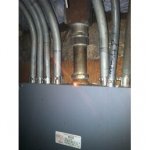JOHNEO99
Senior Member
- Location
- Northern Illinois
I went to a friends bar to look at one of his two panels a month ago. He has a 2 gang meter socket outside that has a 120/240V 200 amp riser. From the can there are two pipes going down into the basement. One pipe is a one inch feed to a 100 amp panel and the other pipe is a one and one half inch pipe going to a 125 amp panel. The first time I looked at this job I noticed a breaker was tripped so I folded it out and noticed that the breaker had damaged the bus bar so I told my buddy he should change out this panel. I moved the breaker to a different position and said I would do it for him for time and material since he is a good friend and I have already done some things over there pro bono. I also told him I would only charge him 20$/hr. which is less than 50% of what I bid things out at. He scoffed and said "I dunno man lets just see how it goes". I told him its gonna go the same way and I also have to make sure the circuits are phased properly and everything is grounded and bonded correctly or the new panel may do the same thing. My buddy is notoriously cheap and said he will let me know when I can do the work. I told him it would only cost him 500-600$ because he is a friend.
Today I get a text from him saying that the main pipe going to the can is too hot to keep his hand on it and something sounds like its frying bacon. I told him I would come out right away to look at it again and do the work if he let me. So I go out to look at it again so as to make sure I have all the material i need since its been a while since I looked at it. I immediately felt the raceway going out to the can and it was pretty damn hot. I looked for loose wires in the main breaker then I went outside to look at the can to see if anything was loose. All the wires were tight and looked to be the correct size. I also noticed the wires themselves were not hot just the raceway.
I really didn't have time to check all the wiring and bonding/grounding but besides overloading (which I didn't see) I am thinking something is going on with the neutrals. It just seems odd to me that this raceway could get so darn hot. I haven't seen anything quite like this. I have seen hot wires but never a hot pipe like this. I am wondering if the raceway has become the neutral and how it could if the neutral is connected right between the can and the panel. I'm a little perplexed but I am sure we will right this.
Has anyone ever experienced something like this and if so what was it?
Today I get a text from him saying that the main pipe going to the can is too hot to keep his hand on it and something sounds like its frying bacon. I told him I would come out right away to look at it again and do the work if he let me. So I go out to look at it again so as to make sure I have all the material i need since its been a while since I looked at it. I immediately felt the raceway going out to the can and it was pretty damn hot. I looked for loose wires in the main breaker then I went outside to look at the can to see if anything was loose. All the wires were tight and looked to be the correct size. I also noticed the wires themselves were not hot just the raceway.
I really didn't have time to check all the wiring and bonding/grounding but besides overloading (which I didn't see) I am thinking something is going on with the neutrals. It just seems odd to me that this raceway could get so darn hot. I haven't seen anything quite like this. I have seen hot wires but never a hot pipe like this. I am wondering if the raceway has become the neutral and how it could if the neutral is connected right between the can and the panel. I'm a little perplexed but I am sure we will right this.
Has anyone ever experienced something like this and if so what was it?


